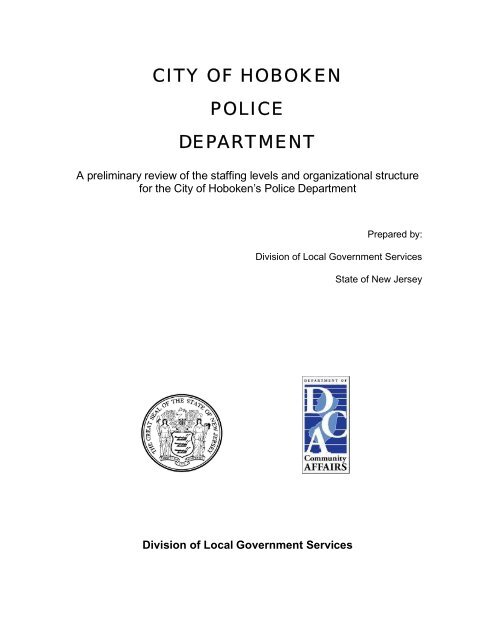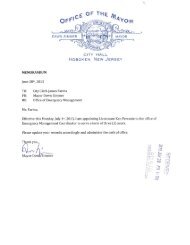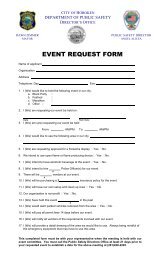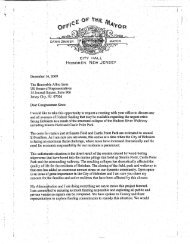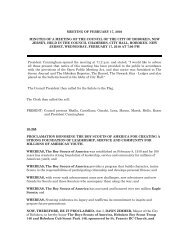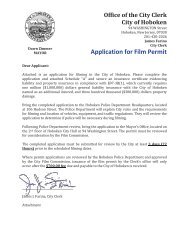CITY OF HOBOKEN POLICE DEPARTMENT - Hoboken NJ
CITY OF HOBOKEN POLICE DEPARTMENT - Hoboken NJ
CITY OF HOBOKEN POLICE DEPARTMENT - Hoboken NJ
Create successful ePaper yourself
Turn your PDF publications into a flip-book with our unique Google optimized e-Paper software.
<strong>CITY</strong> <strong>OF</strong> <strong>HOBOKEN</strong><br />
<strong>POLICE</strong><br />
<strong>DEPARTMENT</strong><br />
A preliminary review of the staffing levels and organizational structure<br />
for the City of <strong>Hoboken</strong>’s Police Department<br />
Prepared by:<br />
Division of Local Government Services<br />
State of New Jersey<br />
Division of Local Government Services
Table of Contents<br />
Executive Summary.......................................................................................4<br />
Overview.........................................................................................................8<br />
I. Methodology and Framework for Staffing.........................................................13<br />
A. Calls for Service Method ........................................................................22<br />
B. Police Officer Availability ........................................................................23<br />
C. CFS Staffing Analysis - Data Information by <strong>Hoboken</strong> PD.........................24<br />
D. Alternate Staffing Method of Analysis ...........................................................25<br />
E. Use of Special Law Enforcement Officers....................................................28<br />
II. Organizational Unit Chart...........................................................................29<br />
III. Director of Public Safety...................................................................................30<br />
IV. Civilianization ...................................................................................................31<br />
V. Administrative and Procedural.........................................................................31<br />
VI. Fleet and Facilities ...........................................................................................32<br />
CONCLUSION.......................................................................................................36<br />
V. Proposed Table of Organization..........................................................37<br />
Appendix A – Police Administration ..........................................................37<br />
Appendix B – Patrol Function............................................................. 38<br />
Appendix C – Criminal Investigations..................................................39<br />
Appendix D – Records Management ..................................................40<br />
Appendix E – State Supervision Resolution........................................41
EXECUTIVE SUMMARY<br />
The Division of Local Government Services (DLGS) conducted an assessment of<br />
the <strong>Hoboken</strong> Police Department (HPD) at the request of then <strong>Hoboken</strong> City Mayor<br />
David Roberts and as a part of the State Supervision statute. The executive<br />
summary presents an overview of the findings presented throughout the report.<br />
General<br />
Upon review of the <strong>Hoboken</strong> Police Department, DLGS staff generally found the<br />
Department in need of consistent and reliable leadership, amended staffing numbers<br />
and technologically sufficient equipment to meet the policing needs of <strong>Hoboken</strong>.<br />
The facilities and physical support of the HPD must be brought into line with the<br />
expanded needs and responsibilities of the Department in order to best provide<br />
police service to the City of <strong>Hoboken</strong>.<br />
As the time this report was initiated, there was a change in municipal administration<br />
and a change in the leadership of the Police Department. In addition, the City of<br />
<strong>Hoboken</strong> had been placed under state supervision for reasons unrelated to the<br />
Police Department.<br />
DLGS believes the HPD rank and file employees want to proactively face new<br />
challenges; however, the relatively new leadership in the positions of Police Chief<br />
and Director of Public Safety are, at this point, untested. The Governing Body,<br />
appropriately, is concerned with the financial aspects associated with providing and<br />
delivering quality police services. DLGS recognizes the costs of providing police<br />
services constitutes a large portion of resources available to the City.<br />
DLGS notes, however, that the changes as suggested within will take time and<br />
resources. Once the relevant parties have read this report, DLGS staff will<br />
welcome the opportunity to aid in the development of a plan to accomplish the<br />
goals set forth within this report.<br />
4
Summary of Recommendations:<br />
The summary is divided into three sections: Organization and staffing; administrative<br />
and procedural; fleet and facilities. The DLGS report should act as a “blue print” for the<br />
<strong>Hoboken</strong> Mayor and Council and the <strong>Hoboken</strong> Police Department to achieve the most<br />
effective and fiscally efficient Police Department for the City. The HPD should have<br />
periodic meetings with both the City Administration and the Director of Public Safety (if<br />
continued) to ensure the recommendations made in this report are met in a timely<br />
manner.<br />
Organization, Staffing and Operations:<br />
A. At the present time, the City has a Director of Public Safety. While<br />
DLGS understands that there may be advantages in maintaining this<br />
position, with respect to the needs of <strong>Hoboken</strong> we suggest the Mayor<br />
evaluate the present and future needs of the administration and the City<br />
to determine whether the City’s administration benefits from this<br />
position.<br />
B. The staffing needs for the HPD are 1 Chief, 3 Captains, 12 Lieutenants,<br />
26 Sergeants and 60 or 70 Officers/detectives depending on the<br />
methodology applied. This determination reflects a reduction in staff<br />
from 158 to 112 or 102 depending on the methodology employed.<br />
C. The Table of Organization must be realigned to meet the current staffing<br />
and needs of the Department and to meet supervisory and oversight<br />
demands.<br />
D. There should be adjustments in deployment to assure coverage. The<br />
current work schedule allows for a 35-hour work week (1824 hours per<br />
year). This is 255 hours less than the desired 40-hour work week (2,080<br />
hours per year) which is 38,500 hours for the department - an equivalent<br />
of 18 officers. The Mayor may choose to raise this with labor<br />
negotiators to determine the net cost effectiveness to employing a 40-<br />
hour work week.<br />
E. There should be civilianization of several positions currently performed<br />
by police officers in order that more police officers are on the street.<br />
DLGS recommends civilianization in the Records Bureau, Training,<br />
Property and Evidence, Information Technology and Dispatch<br />
Supervision.<br />
5
F. Special Law Enforcement Officers (SLEO)s should be hired to perform<br />
the allowable duties in order that more police officers are devoted to<br />
power shifts and high crime areas. This is especially pertinent when<br />
<strong>Hoboken</strong> “hosts” special events or during high population times when<br />
the clubs/restaurants are open late. The City should develop a fee<br />
ordinance for special events to assure that the cost of additional police<br />
coverage is borne and/or defrayed by those directly needing the<br />
services.<br />
Administrative and Procedural:<br />
A. All relevant ordinances must be brought into compliance with the Rules<br />
and Regulations promulgated by the Division of Criminal Justice.<br />
B. All written directives must be brought into compliance with the Division<br />
of Criminal Justice guidelines regarding developing a written directive<br />
system.<br />
C. All Standard Operating Procedures (SOPs) must be reviewed<br />
immediately for relevancy, statutory compliance and thereafter, a<br />
regular schedule of review must be implemented.<br />
D. All administrative processes (such as secondary employment) must be<br />
in compliance with State directives.<br />
E. New fees should be implemented where available. Fee ordinances<br />
should be amended.<br />
Fleet and Facilities:<br />
A. All buildings, and specifically police areas, must be secured both during<br />
and after business hours.<br />
B. The current facilities are adequate to house the Police Department.<br />
C. A continuing cleaning, refurbishment, and/or rehabilitation program for<br />
current facilities should be implemented.<br />
D. The fleet is maintained by the Environmental Services Department (ESD)<br />
and is adequate at this time. A vehicle replacement plan needs to be<br />
developed based on the cost to maintain vehicles.<br />
6
E. The fleet and facilities must be technologically updated. Police personnel<br />
(both civilian and sworn) must have the tools to efficiently deliver services<br />
to the community.<br />
7
OVERVIEW<br />
City of <strong>Hoboken</strong><br />
The City of <strong>Hoboken</strong>, located in Hudson County, has a population of 38,577, according<br />
to the 2000 US Census Survey. The ethnic makeup is 27,197 (70.5%) white; 7,793<br />
(20.2%) Hispanic; 2,932 (7.6%) other; and 1,659 (4.3%) African American. The City<br />
borders Jersey City, Union City, Secaucus, and Weehawken. The City is approximately<br />
1.3 square miles.<br />
On September 10, 2008, the Local Finance Board placed the City of <strong>Hoboken</strong> under<br />
State Supervision pursuant to N.J.S.A. 52:27BB-54 et. seq. after a judicial determination<br />
that “.... [the City’s] gross failure to comply with the Local Bond Law, N.J.S.A. 40A:4-1<br />
et. seq., the Local Budget Law, N.J.S.A. 40A:4-1 et. seq. or the Local Fiscal Affairs Law,<br />
N.J.S.A. 40A:5-1 et. seq., which failure substantially jeopardizes the fiscal integrity of<br />
the municipality.” 1 The Supervision was renewed on September 9, 2009 for an<br />
additional year after the City’s Council again failed to introduce and adopt an<br />
appropriate balanced budget. 2 The Local Finance Board’s Resolution granted broad<br />
statutory powers to the Director of Division of Local Government Services who, in turn,<br />
delegated broad powers to a Fiscal Monitor hired by the City. The <strong>Hoboken</strong> Fiscal<br />
Monitor has broad powers under the aforesaid statutes.<br />
The broad powers include, but are not limited to, creating a budget, proposing<br />
resolutions, and contract negotiations. With a Fiscal Monitor, neither the DLGS nor the<br />
Director has a role in the direct fiscal management of the City, nor do they have a role in<br />
contract negotiations. The DLGS acknowledges that during the time of this report’s<br />
creation, there are ongoing police contract negotiations. While this report’s<br />
recommendations may affect the staffing and City’s fiscal obligation to the HPD, this<br />
report has no direct role in the contract negotiations.<br />
1<br />
2<br />
See. Local Finance Board Resolution (attached as Appendix E)<br />
Id.<br />
8
Crime Rate 3<br />
<strong>Hoboken</strong><br />
PD<br />
2005 2006 2007 2008<br />
Crime<br />
Index 4 1,521 1194 1183 1186<br />
Violent 118 116 158 156<br />
Non-Violent 1,403 1078 1025 1030<br />
Crime/1000 37.9 29.9 29.7 29.2<br />
Violent/1000 2.90 2.9 4 3.8<br />
Non-<br />
Violent/1000 34.90 27 25.7 25.4<br />
Under the New Jersey Uniform Crime Reports promulgated by the New Jersey State<br />
Police, the Crime Rate is the number of Crime Index offenses reported for each unit of<br />
population per 1,000. The “Crime Index” is calculated by adding the violent and nonviolent<br />
reported crime in a given year. The Crime Index consists of seven major<br />
offenses separated into violent (murder, rape, robbery and aggravated assault) and<br />
non-violent crimes (burglary, larceny-theft and motor vehicle theft).<br />
<strong>Hoboken</strong> Police Crime Index<br />
1,600<br />
1,400<br />
1,200<br />
1,000<br />
800<br />
600<br />
400<br />
200<br />
0<br />
2005 2006 2007 2008<br />
Crime Index 1,521 1194 1183 1186<br />
3 All charts and figures were compiled from the Uniform Crime Reports of New Jersey.<br />
http://www.state.nj.us/njsp/info/stats.html<br />
4 New Jersey State Police 2008 Uniform Crime Reports, Glossary of Terms. Crime Index: The total of the seven<br />
major offenses used to measure the extent, fluctuation and distribution of crime in a geographical area. The<br />
following crimes make up the index: Murder, rape, robbery, aggravated assault, burglary, larceny-theft, and<br />
motor vehicle theft; these offenses are referred to as Index offenses.<br />
9
<strong>Hoboken</strong> Police Violent Crime<br />
180<br />
160<br />
140<br />
120<br />
100<br />
80<br />
60<br />
40<br />
20<br />
0<br />
2005 2006 2007 2008<br />
Violent 118 116 158 156<br />
<strong>Hoboken</strong> Police Non-Violent<br />
1,600<br />
1,400<br />
1,200<br />
1,000<br />
800<br />
600<br />
400<br />
200<br />
0<br />
2005 2006 2007 2008<br />
Non-Violent 1,403 1078 1025 1030<br />
10
The <strong>Hoboken</strong> Police Crime Index indicates that crime, as a total of both violent and nonviolent<br />
crime has decreased. Though the violent crime has increased from 2006 to<br />
2007, the severe drop in non-violent crime gives a total crime rate decrease in the same<br />
period. The total crime per 1,000 population indicates a slight decrease in crime. In<br />
determining the staffing needs of the Police Department, DLGS staff considers crime<br />
statistics in their evaluation.<br />
<strong>Hoboken</strong> Police Crime/1000 Population<br />
40.0<br />
35.0<br />
30.0<br />
25.0<br />
20.0<br />
15.0<br />
10.0<br />
5.0<br />
0.0<br />
2005 2006 2007 2008<br />
Crime/1000 37.9 29.9 29.7 29.2<br />
Policing in an urban/suburban 5 community, such as <strong>Hoboken</strong>, and in any community<br />
is a far more complex set of activities than many people recognize. To many citizens,<br />
the police are simply crime fighters whose responsibility is to protect people's safety<br />
and property, and to enhance the public's sense of security. There are, however, a<br />
myriad of other responsibilities the police discharge on a daily basis, including<br />
preserving order in the community, guaranteeing the movement of pedestrian and<br />
vehicular traffic, protecting and extending the rights of persons to speak and assemble<br />
freely, and providing assistance for those who cannot assist themselves.<br />
<strong>Hoboken</strong> Police Department (HPD) provides the community with a total spectrum<br />
of policing, spanning a full range of<br />
services that include response to<br />
5 As defined under the <strong>NJ</strong> Dept. of Law & Public Safety Uniform Crime Report (UCR)<br />
11
emergencies, response to calls for service, directed activities, and problem<br />
solving; however, the interaction and communication between the police and the<br />
community needs improvement.<br />
<strong>Hoboken</strong> has had its share of problems and issues as there have been police events<br />
reported in the media concerning on and off-duty actions by police officers, which<br />
have invoked strong citizen criticism, and editorials which has defined it as a<br />
department in crisis. The inappropriate actions of some officers have impacted the<br />
entire Police Department; however, the Police Department is at a crossroads. An<br />
immediate change and long-term commitment by both the Police Department and<br />
the Administration is needed to improve the entire department.<br />
There must be an effort by the incoming city and police administrations, command<br />
staff and the first-line supervisors to change and develop a new culture. DLGS<br />
suggestions reflect an acceptable police industry method for determining staffing<br />
levels while making available sound contemporary supervisory concepts to improve<br />
the efficiently, effectiveness and performance of the HPD.<br />
12
I. Methodology and Framework for Staffing<br />
The assessment of HPD was conducted through data collection, on-site observation<br />
of police personnel, interviews, research, reviews of relevant literature, statutes,<br />
regulations and nationally accepted standards of police organization, comparative<br />
evaluation of police industry standards, meetings, analysis of data, and experience of<br />
DLGS staff.<br />
The International Association of Chiefs of Police has developed a scientific approach<br />
to the distribution of patrolling staffing levels. This approach to the allocation of patrol<br />
staffing as applied in this report has found acceptance among the most progressive<br />
police agencies in the country. Although the system is not perfect, it is much more<br />
effective in allocation methods based upon subjective evaluations of a particular<br />
situation or comparisons to police agencies. The DLGS staff, additionally, utilizes<br />
models taught by Northwestern University Center for Public Safety in the analysis of<br />
the HPD.<br />
DLGS staff intermittently spent approximately 8 weeks interviewing, observing and<br />
collecting data for this report. The DLGS staff met with the Director of Public Safety,<br />
Police Chief and his staff who provided the data used in this report. The DLGS also met<br />
with all the captains (5), a representative sample of lieutenants, sergeants, police<br />
officers and civilian employees to gain an understanding of the operation of the HPD.<br />
Standards and Accepted Practices<br />
<br />
<br />
<br />
<br />
<br />
New Jersey Division of Criminal Justice, Guide to Developing a Written<br />
Directive System, July 2001.<br />
New Jersey Division of Criminal Justice, Model Rules and Regulations, July<br />
2001.<br />
New Jersey Division of Criminal Justice, Attorney General Guidelines,<br />
ongoing publications, See. http://www.state.nj.us/oag/dcj/guides.htm<br />
The Field Operations Division of the International Association of Chief of<br />
Police [IACP], Washington D.C. 20036, on-going.<br />
http://www.theiacp.org/PublicationsGuides/tabid/71/Default.aspx<br />
Standards for Law enforcement Agencies, Commission on Accreditation for<br />
Law Enforcement Agencies (CALEA), Inc. Fairfax, Virginia 22030, on-going.<br />
http://www.calea.org/Online/CALEAPrograms/LawEnforcement/lawenfprogram.htm<br />
13
Analysis Categories<br />
The general categories used for analysis in the study were: Administration and Staffing;<br />
Facilities and Fleet and, in conjunction with these major categories, DLGS staff<br />
reviewed police administration policies, community assessment; physical resources;<br />
human resources; training and competency; and external interactions.<br />
Introduction to the Study’s Parameters<br />
The DLGS recognizes that there is no one right way to organize a police department<br />
and every department must be structured to meet the specific needs of the community it<br />
serves; however, studies including those cited herein, indicate that certain principles of<br />
organization have been proven valid over time and include:<br />
Tasks, similar or related in purpose, processes, methods, or clientele, should be<br />
grouped together in one or more units under the control of one person;<br />
Each task should be clearly and concisely made the duty of an individual;<br />
responsibility for planning, execution, and control should be definitively placed on<br />
designated individuals;<br />
Each individual, unit, and situation should be under the immediate control of one,<br />
and only one, individual, thus achieving the principle of unity of command;<br />
Each assignment or duty should carry with it the authority necessary to fulfill the<br />
responsibility;<br />
Lines of demarcation between the responsibilities of units should be clearly<br />
drawn by a precise definition of the duties of each;<br />
Rank should increase one-step, and only one-step, at each level of the<br />
organization’s structure and be consistent with the duties and responsibilities<br />
assigned to the position;<br />
Personnel who actually supervise others should hold supervisory rank;<br />
Qualified civilian employees should staff functions that can be performed by nonsworn<br />
personnel; and<br />
Non-traditional or highly specialized functions should only be established if a<br />
demonstrated and on-going need exists.<br />
14
These principles, coupled with the corporate knowledge of the community possessed<br />
by the HPD command personnel, should guide the development of an appropriate table<br />
of organization and the operational policies necessary for the future direction of the<br />
HPD.<br />
The HPD must be structured to perform its essential functions efficiently and effectively,<br />
within its fiscal restraints, consistent with the nature and particular needs of the<br />
community it serves. The DLGS will identify positions that should be funded to provide a<br />
recommended level of police service to the City without compromising officer safety.<br />
The timetable to implement these recommended changes is the responsibility of the<br />
Mayor, and the members of the governing body.<br />
The report makes recommendations based on sound police operations principles<br />
that can be applied to <strong>Hoboken</strong> City. The DLGS recommendations include, but are<br />
not limited to, “civilianization” of functions currently performed by police personnel in<br />
order to place additional sworn officers on the street and a decrease in supervisory<br />
personnel.<br />
During the assessment, DLGS staff sought specific documentation from the City, HPD<br />
Administration and the Municipal Court. While the City and HPD provided a portion of<br />
the documents in a timely fashion, the DLGS staff observed the documents provided<br />
were not consistently accurate or were only provided after repeated requests.<br />
A common financial vision between the police leadership, its officers and the City<br />
needs to be established to accomplish the goal of delivering high quality law<br />
enforcement services to the community at a practical cost.<br />
The DLGS staff members, who have studied public safety departments of local<br />
governments within the State of New Jersey, conducted the assessment. The lead<br />
investigator was a member of the Public Safety Liaison team within the DLGS and has<br />
over 25 years police experience with the last seven active duty years as the Police<br />
15
Chief of the 60 sworn officers in Maplewood <strong>NJ</strong>. He is a graduate of the West Point<br />
Leadership School sponsored by the New Jersey Chiefs of Police Association.<br />
Upon retirement from Maplewood 12 years ago, he was hired by the New Jersey<br />
Department of Treasury and assigned to the Local Government Budget Review for<br />
three years. Upon the dissolution of that body, he transferred to the Department of<br />
Community of Affairs for the past nine years. At both organizations, he conducted<br />
reviews of Public Safety organizations to provide technical assistance and<br />
recommend acceptable staffing levels and organization structures.<br />
The DLGS recommendations are not merely to promote efficiency, effectiveness and<br />
performance of the Police Department, but also a blue print for steps that the City may<br />
take to provide fiscally responsible essential police services to the people who live,<br />
work, shop and raise children within the City of <strong>Hoboken</strong>.<br />
16
Staffing<br />
In general, DLGS experience indicates that the largest percentage of municipal budgets<br />
is for public safety functions and, in particular, police functions. A large part of any<br />
police budget is for salary and wages. In order for one to determine whether a police<br />
force is fiscally efficient without sacrificing public safety, one must determine the<br />
optimum level of staffing for the police department given the particular circumstances of<br />
the community.<br />
“Work schedule” and “officer availability” are the first areas of staffing addressed in<br />
this report. An assessment of the police officers’ work schedules will help determine<br />
if the City is scheduling their police force in the most efficient and cost effective<br />
manner. The second area of assessment is man power staffing. Within this report,<br />
police staffing is calculated by two methodologies: “calls for service” methodology<br />
and “alternative staffing/minimum staffing” methodology.<br />
Work Schedule<br />
The Uniformed Patrol squads work 8-hour shifts, five days on, two days off; then four<br />
days on, 3 days off which results in a 35-hour workweek and 1824-hour base work<br />
year. All scheduled time off and the averages for sick, injured, training, personal, and<br />
other days are subtracted from the base year.<br />
The present schedule requires HPD officers to work an average 35 hours a week<br />
(1,824 hours annually before leave time was taken). When compared to a traditional 40-<br />
hour work week (2,080 hours annually before leave time was taken), the HPD officer<br />
schedule is 255 hours less per employee. This is a loss of 38,500 hours of productivity<br />
for the entire department, which is the equivalent of 18.5 officers. Expressed in dollars,<br />
this costs the City approximately $1,700,000 per year. Although hours worked are<br />
defined by contract, this shortfall in hours can be addressed in future labor contracts:<br />
$1,700,000 divided between 158 officers is $10,758 per officer. The Mayor may choose<br />
to raise this with the labor negotiators to determine the net cost effectiveness to<br />
employing a 40-hour work week.<br />
17
CHART A 6<br />
Position Number Total Sal Avg. Salary 7 Avg. Hourly Rate<br />
Police Officer 104 7,064,279 67,925.76 1824 37.24<br />
Supervisor 54 5,376,897 99,572.17 1824 54.59<br />
Lost Salary 104 256 54.59 754,652.21<br />
54 256 37.24 991,477.75<br />
1,746,129.96 Lost Salary<br />
The above Chart A, and Charts B and C on the following page indicate the City “loses”<br />
approximately 1.7M dollars in man hours in calculating a 35-hour work week versus a<br />
40-hour work week. By inference, the City could potentially “save” the lost salary by<br />
going to a 40-hour work week. In order to complete the analysis, if one were to assume<br />
that a 40-hour work week could be contractually negotiated, one must also compute the<br />
cost of the “five additional hours” for the officers involved. To analyze this, the<br />
organizational charts on pages 25, 27, and 29 within, indicate a calculated reduction in<br />
personnel from 66 patrol officers to either 46 or 36 sworn patrol officers, depending<br />
upon the methodology employed. Chart D and E on the following page calculates that a<br />
40-hour work week with a reduction in force to either 36 and 46 officers, respectively,<br />
and including the “five extra hours” would translate to an approximate $3,024,641.31<br />
(36 patrol officers) or $2,250,049.31 (46 patrol officers) savings for the City.<br />
6 Charts A through C evaluate 35 hour versus 40 hour workweeks based on the existing work force of 158<br />
officers<br />
7 Using 2009 <strong>Hoboken</strong> Budget Data<br />
18
CHART B<br />
Existing force @ 35 hrs/wk<br />
Position Number Total Sal. Avg. Sal. Yearly Hours Hourly Rate<br />
Officer 104 $ 7,064,279.00 $ 67,925.76 1824 $ 37.24<br />
Supv. 54 $ 5,376,897.00 $ 99,572.17 1824 $ 54.59<br />
158 $12,441,176.00<br />
CHART C<br />
Existing force @ 40 hrs/wk<br />
Hourly Rate<br />
Yearly Hours<br />
Officer 104 $ 37.24 2080 $ 8,055,756.75<br />
Supv. 54 $ 54.59 2080 $ 6,131,549.21<br />
CHART D<br />
158 $14,187,305.96 $(1,746,129.96)<br />
Reduction in force to 36 patrol officers @ 40 hrs/wk 8<br />
Hourly Rate<br />
Yearly Hours<br />
Officer 60 $ 37.24 2080 $ 4,647,551.97<br />
Supv. 42 $ 54.59 2080 $ 4,768,982.72<br />
132 $9,416,543.69 $3,024,641.31<br />
CHART E<br />
Reduction in force to 46 patrol officers @ 40 hrs/wk 9<br />
Hourly Rate<br />
Yearly Hours<br />
Officer 70 $ 37.24 2080 $ 5,422,143.97<br />
Supv. 42 $ 54.59 2080 $ 4,768,982.72<br />
132 $10,191,126.69 $2,250,049.31<br />
8 Reflects reduction in staff as contained on proposed organizational chart on page 27<br />
9 Reflects reduction in staff as contained on proposed organizational chart on page 25<br />
19
Availability<br />
The term “availability” refers to the average number of days or hours that officers<br />
actually report for work per year. The availability is determined by the work schedule;<br />
the average contracted leave time used and unscheduled time utilized by an average<br />
officer. In <strong>Hoboken</strong>, the average officer assigned to the Patrol Bureau works 1,450 hour<br />
a year. See chart below.<br />
<br />
<br />
<br />
Vacation Days: The average number of vacation days used by officers was<br />
19.6 days or 156.8 hours. The number of available vacation days may vary<br />
depending upon time in service.<br />
Holidays: The average number of holidays used was 14 days or 112 hours.<br />
Note: the existing contract calls for 14 holidays.<br />
Sick Days: The average number of sick days taken by officers was 9.9 days<br />
or 679.2 hours. The number of contractually given sick days is addressed<br />
through giving flat rate payouts for “perfect attendance” ($1500) and a<br />
decreasing scale for occurrence of illness.<br />
On Duty Injured (OJI) Time: The average number of OJI days used was 0.58<br />
days or 4.64 hours.<br />
Training Days: The average officer is excused from duty 0.63 days or 5.04<br />
hours.<br />
<br />
Blood/PT Other Days: 2.06 days or 16.48 hours include time off for donating<br />
blood, jury duty, marriage leave, union business, conventions and other<br />
excused absences used by the average officer. “Blood time” is one day for<br />
each time the officer gives blood or blood day in emergency for a needy city<br />
employee, 3 days off, maximum 5 days a year<br />
20
<strong>Hoboken</strong> Police<br />
Department<br />
<strong>OF</strong>FICER<br />
AVAILABILITY<br />
Patrol Schedule DAYS HOURS<br />
Base year 8 hr days 365 2920<br />
Scheduled days off 137 1096<br />
Scheduled work days 228 1824<br />
Vacation 19.6 156.8<br />
Sick 9.9 79.2<br />
OJI 0.58 4.64<br />
0 0<br />
Training 0.63 5.04<br />
Blood/PT 2.06 16.48<br />
Holidays 14 112<br />
Average Availability 181.23 1450<br />
The above chart reflects the days generally used in the calculation of officer availability.<br />
These categories are consistent in the modeling taught by the Field Operations Division<br />
of the International Association of Chief of Police [IACP], the Standards for Law<br />
Enforcement Agencies, Commission on Accreditation for Law Enforcement Agencies<br />
(CALEA), and the Northwestern University Center for Public Safety. In addition to<br />
the days delineated above, the HPD contract calls for the following paid leave:<br />
<br />
<br />
<br />
<br />
Bereavement Leave for immediate family from date of death to funeral; not to<br />
exceed 5 days;<br />
Marriage of employee - 6 consecutive days off;<br />
One day off for each time of Baptism, communion, confirmation, Bar/Bat<br />
Mitzvah, and Graduation (not defined) including one day off if employee is the<br />
Godfather, godmother, Maid of honor, bridesmaid, groomsman of wedding;<br />
and<br />
Three days emergency leave for immediate family illness.<br />
Although most employment, including police, contracts include a provision for<br />
Bereavement Leave and many include a provision for emergency leave for family<br />
illness, few contracts include marriage, baptism, bar mitzvah, or leave for donating<br />
21
lood. The Mayor may choose to meet with labor counsel to determine the “worth” of<br />
these provisions.<br />
Minimum Staffing Level Methodology<br />
There are several methods used to estimate the minimum level of patrol staffing for<br />
a Department. The selection of the most appropriate method is based on a number<br />
of factors, including the size of the Department, the overall workload, and the quality<br />
of the data available. Data derived from the Computer Aided Dispatch system (CAD)<br />
is used to determine the number and type of calls for service (CFS) the Department<br />
responds to over time. The data is used to identify the minimum number of officers<br />
considered necessary to staff the Patrol Division while maintaining a safe community<br />
environment. The number does not include supervisors or traffic officers who do not<br />
normally respond to emergency assignments. DLGS utilizes the “Calls for Service”<br />
model and the “Alternative Staffing” model for determining the minimum staffing<br />
number. DLGS utilizes the “Calls For Service” model and the “Alternative Staffing”<br />
model for determining the minimum staffing number because these are the two<br />
models most frequently used in determine police department staffing numbers.<br />
A. Calls for Service Method<br />
The first method used is the Calls for Service (CFS) method, which is based on the<br />
number of CFS handled by the Department and thus, based on “workload”. Each<br />
CFS, either generated by phone and dispatched by the Department or initiated by<br />
Officers while on patrol, is entered into the Computer Aided Dispatch (CAD) system,<br />
which enables the Department to track the call and the time it takes to complete the<br />
assignment. Information gathered should include the time, location, type, units<br />
assigned, and disposition.<br />
According to data supplied, the Department responded to 60,031 calls for service in<br />
2008. The <strong>Hoboken</strong> CAD classifies 98 categories of police activity but not all<br />
recorded activities are used for this calculation. All administrative calls, CAD entries<br />
for investigations initiated by detectives and self-initiated traffic stops, are eliminated<br />
22
and factored into other portions of the calculation. The average time per call<br />
furnished by the CAD was 22.27 minutes per call.<br />
Multiplying 60,031 calls by an average time of 22.27 minutes per call results in<br />
22,211 hours of “obligated” time that is used servicing calls. The accepted rule for<br />
utilization of time spent by patrol officers is one third of time is spent answering calls<br />
(obligated time), one third of time is used for administrative responsibilities and one<br />
third is “unobligated” time. This ratio is derived from best practices taught at the<br />
Northwestern University Center for Public Safety. Unobligated time is also known as<br />
preventive patrol, described as being “oriented toward the prevention of crimes and<br />
accidents, maintenance of public order, and discovery of hazards and delinquencycausing<br />
situations” (CALEA). Generally, this method has proven reliable compared<br />
to more detailed and complex analyses. In order to compensate or adjust for<br />
administrative time and unobligated time, a factor of three is used by multiplying<br />
22,211 hours (obligated time) by 3 results in 566,634 total hours per year of patrol<br />
officers’ time. Dividing 66,634 by 1,450 (officer availability), the result is 46 officers<br />
considered necessary to staff the patrol squads.<br />
B. Police Officer Availability<br />
It is also necessary to calculate the average number of hours an officer reports to work.<br />
To calculate this, the Division of Local Government (DLGS) has used a public safety<br />
availability model based on methods taught by the Northwestern University Center for<br />
Public Safety and data supplied by the HPD.<br />
In order to determine and justify the size of the Department, the Police Chief must<br />
establish how many officers are essential to staff the uniformed patrol force. To do<br />
this effectively, the Chief must know the amount and type of workload by time and<br />
location, the time it takes to clear the call, and the time that officers are actually at<br />
work. Demands for police service occur in fairly predictable and systematic patterns<br />
over an extended period. Consideration must be given to days off, vacations,<br />
holidays, training and other activities, which detract from productive patrol time<br />
23
C. CFS Staffing Analysis/ Data Information<br />
Multiplying 60,031 CFS by the time consumed per call of 22.27 minutes (.37) per call,<br />
results in 22,211 hours of obligated time, which is directly spent on service calls.<br />
Then multiplying 22,211 (obligated time) by 3 results in 66,634 total hours per year in<br />
patrol officers’ time. Dividing 66,634 by 1,450 (officer availability), the result indicates a<br />
minimum of 46 officers are needed to staff the Patrol Bureau.<br />
CFS 60,031 Total time 22211.47 Patrol time 66634.41<br />
Time/call 0.37 Factor 3 Availability 1450<br />
Total time 22211.47 Patrol time 66634.41 Officers 46.0<br />
Acknowledging the importance of patrol, the Chief’s staff should conduct periodic<br />
reviews of the workload analysis to ensure adequate coverage with accurate data<br />
information.<br />
24
CALLS FOR SERVICE STAFFING CHART<br />
(Indicating a minimum of 46 patrol officers)<br />
Organizational Unit Chief Captain Lieutenant Sergeant<br />
Police<br />
Officer<br />
Total<br />
Director of Public Safety<br />
Chief's Office 1 1<br />
Professional Standards<br />
Internal Affairs<br />
1 1 1 3<br />
Planning/Training/ Operations/ Budget/Grants/ 1 1 1 3<br />
Patrol Operations 1 8 16 46 71<br />
Communications<br />
PST Dispatchers 911<br />
Traffic Section 1 3 4<br />
Community Policing<br />
And SRO’s<br />
1 2 6 9<br />
Criminal Investigations 1 1 3 6 11<br />
Juvenile Aide Section 1 1 2<br />
Anti-crime 1 3 4<br />
Property& Evidence<br />
Administration/Support 1 1<br />
Bureau of Identification 2 2<br />
Alcoholic Beverage Control 1 1<br />
Fleet/Facilities/Equipment<br />
Information Technology<br />
Records<br />
TOTAL 1 3(4) 12 (19) 26(30)<br />
70<br />
(104)<br />
112<br />
(158)<br />
Numbers in parentheses indicate current staffing. This chart indicates a reduction of 46<br />
positions (from 158 to 112 sworn officers). 10<br />
D. Alternate Staffing Method of Analysis/Minimum Staffing Method<br />
Another method used to determine staffing of the patrol division is the “minimum staffing<br />
method”, which is based of the “safety” of the officers. The method requires the Chief<br />
determine the minimum amount of officers needed to safely deploy a patrol squad and<br />
the minimum number of officers available for service delivery before recalling officers for<br />
10 A reduction in patrol officers would indicate a reduction in supervisory personnel as well.<br />
25
overtime. The Chief has determined that the minimum staffing is 6 officers on the first<br />
shift, 6 officers on the second shift and 6 officers on the third shift.<br />
Multiplying 18 by the length of the tours of 8 hours, the result is 144 hours per day or<br />
43,800 hours per year. Dividing the total hours per year by the officer availability of<br />
1,450 hours, the result is 36.25 officers needed to staff the Patrol Bureau.<br />
Alternate Method Analysis<br />
Beat/day 18 Hours/day 144 Hours/year 52560<br />
Hour/shift 8 Days 365 Availability 1450<br />
Hours/day 144 Hours/year 52560 Officers 36.25<br />
26
ALTERNATE METHOD STAFFING CHART<br />
(Indicating a minimum of 36 patrol officers)<br />
Organizational Unit Chief Captain Lieutenant Sergeant<br />
Police<br />
Officer<br />
Total<br />
Director of Public Safety<br />
Chief's Office 1 1<br />
Professional Standards<br />
Internal Affairs<br />
1 1 1 3<br />
Planning/Training/ Operations/ Budget/Grants/ 1 1 1 3<br />
Patrol Operations 1 8 16 36 61<br />
Communications<br />
PST Dispatchers 911<br />
Traffic Section 1 3 4<br />
Community Policing<br />
And SRO’s<br />
1 2 6 9<br />
Criminal Investigations 1 1 3 6 11<br />
Juvenile Aide Section 1 1 2<br />
Anti-crime 1 3 4<br />
Property& Evidence<br />
Administration/Support 1 1<br />
Bureau of Identification 2 2<br />
Alcoholic Beverage Control 1 1<br />
Fleet/Facilities/Equipment<br />
Information Technology<br />
Records<br />
TOTAL 1 3(4) 12 (19) 26(30)<br />
60<br />
(104)<br />
102<br />
(158)<br />
Numbers in parentheses indicate current staffing. This chart indicates a reduction of 56<br />
positions (from 158 to 102 sworn officers). 11<br />
The above two methodologies are the most widely used and accepted<br />
methodologies in determining minimum police staffing. Though the two<br />
methodologies (“workload” and “minimum staffing”) have different results, they both<br />
reflect minimum levels of police staffing (patrol officers). Many factors particular to<br />
the municipality must also be considered when determining police staffing minimum<br />
11 See Footnote No. 9.<br />
27
numbers. The two methodologies utilized in this report indicate minimum calculated<br />
levels. The Mayor and the Police Chief are in the best positions to determine the<br />
factors particular to <strong>Hoboken</strong>. Once the staffing is determined, the supervisory<br />
staffing should be adjusted accordingly. The reduction of one Captain, seven (7)<br />
Lieutenants, and four (4) Sergeants as indicated on the above Charts are based on<br />
the reduction of patrol officers to 66 patrol officers. Once the Mayor and Police Chief<br />
determine the appropriate staffing for patrol officers, DLGS can assist the calculation<br />
of appropriate supervisory personnel.<br />
Any reduction in staff may be accomplished through a variety of means or<br />
combination of means, including but not limited to attrition, lay-offs, elimination of<br />
positions or other method statutorily permitted. The Mayor may choose to explore<br />
any of these alternatives.<br />
E. Use of Special Law Enforcement Officers<br />
There are some circumstances where Special Law Enforcement Officers (SLEOs)<br />
should be hired to perform the allowable duties in order that more police officers are<br />
devoted to power shifts and high crime areas. At times, the City of <strong>Hoboken</strong> had to<br />
“close its borders” when traffic volume became excessive either during special<br />
events or when the clubs were open. The City’s administration may find it cost<br />
effective to hire SLEOs as opposed to paying overtime or for extra officers on duty.<br />
This is especially pertinent when <strong>Hoboken</strong> “hosts” special events or during high<br />
population times when the clubs/restaurants are open late.<br />
Further, in these challenging fiscal times, the City should look to the proponents of<br />
the events for sponsorship, contribution and/or secondary employment payment<br />
when police officers are needed for special events. For example, in Philadelphia,<br />
the City is now asking the sponsors of parades such as the Mummers Parade and<br />
the various “ethnic” parades for payment to help defray the cost of the police officers<br />
and other personnel assigned to the special event. In <strong>Hoboken</strong>, special events such<br />
28
as the St. Patrick’s parade, the Fourth of July fireworks or regular events such as the<br />
“Club scene” in <strong>Hoboken</strong> may require private contributions to help defray there<br />
police deployment expenses. Any such fees or secondary employment must be<br />
accomplished through statutory and appropriate administrative means.<br />
II. Organizational Unit Chart<br />
If the bureaus, divisions, sections and units were organized as recommended by DLGS,<br />
the overall department staffing would be as follows:<br />
Organizational Unit Chief Captain Lieutenant Sergeant<br />
Police<br />
Officer<br />
Total<br />
Director of Public Safety<br />
Chief's Office 1 1<br />
Professional Standards<br />
Internal Affairs<br />
1 1 1 3<br />
Planning/Training/ Operations/<br />
Budget/Grants/ 1 1 1 3<br />
Patrol Operations 1 8 16 46/36 71/61<br />
Communications<br />
PST Dispatchers 911<br />
Traffic Section 1 3 4<br />
Community Policing<br />
And SRO’s<br />
1 2 6 9<br />
Criminal Investigations 1 1 3 6 11<br />
Juvenile Aide Section 1 1 2<br />
Anti-crime 1 3 4<br />
Property& Evidence<br />
Administration/Support 1 1<br />
Bureau of Identification 2 2<br />
Alcoholic Beverage Control 1 1<br />
Fleet/Facilities/Equipment<br />
Information Technology<br />
Records<br />
TOTAL 1 3(4) 12 (19) 26(30)<br />
70/60<br />
(104)<br />
112,102<br />
(158)<br />
Numbers in parentheses indicate current staffing. This chart indicates a reduction of 46<br />
or 56 positions (from 158 to 112 or 102 sworn officers). Depending on the final number<br />
of sworn officers, further adjustments to the supervisory personnel would likely be in<br />
order.<br />
29
The proposed organization charts are for each of the line and administration<br />
functions. (See the attached Appendices)<br />
III. Director of Public Safety<br />
At the present time, the City employs a Director of Public Safety. Municipalities that<br />
employ a Director of Public Safety do so for various reasons. In the City of<br />
<strong>Hoboken</strong>, various administrations view this position from both sides – some see the<br />
necessity of a Director of Public Safety, while others feel that a Chief is sufficient.<br />
During the time DLGS reviewed the HPD and reviewed the Director of Public<br />
Safety’s position, DLGS staff found that the position of Director of Public Safety in<br />
unnecessary for managing this city’s Police Department. 12<br />
Based on our information and observations over the past year, there is no apparent<br />
advantage to maintaining the Director of Public Safety position. The position creates an<br />
additional financial burden to the city. The Police and Fire Chiefs can (with direction<br />
from the Mayor) make policy and provide financial guidance on their respective<br />
budgets.<br />
While DLGS understands that there may be advantages in maintaining this position,<br />
we suggest that the Mayor evaluate the present and future needs of the<br />
administration and the City to determine whether the City’s administration benefits<br />
from this position. Based on DLGS evaluations and observations while conducting<br />
this study, any advantages attributed to the Director of Public Safety are negligible<br />
and we recommend elimination of the position.<br />
12 This report does not pass judgment on the position of Director of Public Safety or similar positions in other<br />
municipalities in the state.<br />
30
IV. Civilianization<br />
The HPD, like most police departments, is confronting increasing demands for services<br />
while facing fiscal constraints. The increased prudent use of civilian employees is one<br />
method to meet this challenge. Civilianization enables more sworn officers to answer<br />
service calls that require full police powers. The HPD must begin the process of<br />
identifying positions for civilian employees.<br />
The HPD can determine positions to be civilianized by asking the following questions:<br />
Does the position involve responding to police emergencies<br />
Does the position require police officer status or arrest powers<br />
To ensure the success of this implementation program, prudent personnel selection and<br />
effective training are essential elements to the program. Hiring retired police officers to<br />
non-uniformed civilian positions may be a positive alternative given that the retired<br />
officer has the advantage of knowing the job and personnel within the City.<br />
DLGS recommends that the HPD Administration can increase utilization of police<br />
officers by identifying positions where a civilian should be utilized in the following areas;<br />
Record Bureau, Training, Property and Evidence Management, Information Technology<br />
and Dispatch Supervision. This list represents a minimum of eight sworn officers who<br />
could be placed back on patrol with appropriately trained civilians in these areas. This<br />
civilianization should be accomplished in concert with the reduction in sworn officers.<br />
V. Administrative and Procedural<br />
After a review of the administrative code and the standard operating procedures<br />
(SOPs) of the City and its Police Department, DLGS found most procedures and<br />
codes up-to-date with current laws and statutes. The Administration and the Police<br />
Chief must ensure that all relative ordinances must be brought into compliance with<br />
the Rules and Regulations promulgated by the Division of Criminal Justice and with<br />
the current state of the Police Department as the recommendations within this report<br />
are implemented.<br />
31
Further, the Police Chief and staff must make sure that all written directives are<br />
brought into and maintained in compliance with the Division of Criminal Justice<br />
guidelines regarding a written directive system.<br />
All SOPs should be reviewed immediately for relevancy, statutory compliance and<br />
thereafter, a regular schedule of review must be implemented. It is imperative that a<br />
written and known procedure for periodic SOP review is conducted. The<br />
Administration in conjunction with the Police Chief and the Director of Public Safety<br />
(if applicable), may wish to involve the City’s Solicitor and/or legal counsel in this<br />
review.<br />
All administrative processes (such as secondary employment) must comply with<br />
State directives and should be reviewed by the Administration and relevant fiscal<br />
staff. New fees should be implemented where applicable. Fee ordinances should be<br />
amended to ensure that the appropriate and timely fees are being collected in the<br />
appropriate fiscal manner.<br />
VI. Fleet and Facilities<br />
Facilities<br />
The police facilities are located at 1 Police Plaza in a stand alone building located on<br />
Hudson Street. The building appears secure with officers assigned to the desk to<br />
direct visitors to the appropriate offices. The floor space is adequate for the<br />
operation as currently staffed. The main problem is secure storage, which is<br />
addressed with temporary facilities located in the parking area and at the central<br />
garage. This “temporary storage” must be addressed to ensure that records<br />
retention requirements are met. The overall condition of the building is fair, but in<br />
need of updating, cleaning, refurbishment and/or rehabilitation. All buildings, and<br />
specifically police areas, must be secured both during and after business hours.<br />
32
Fleet Issues<br />
General<br />
The responsibility for the police fleet, which includes purchasing decisions for<br />
vehicles, equipment installed in the vehicles, training on the equipment in the<br />
vehicles, and coordinating maintenance of the vehicles lies with the Traffic Division.<br />
The fleet includes 54 cars and other vehicles cars, 16 motorcycles, and 2 radar<br />
traffic trailers. Some of the vehicles on the list are out-of-service waiting to be sold.<br />
The choice of cars has been the Ford Crown Victoria Police Interceptor (CVPI) for<br />
most police use. Consideration should be given to purchasing police package<br />
Chevrolet Impalas or Dodge Chargers (V-6) that have lower purchase costs and<br />
deliver higher gasoline mileage.<br />
DLGS notes that many Police Departments statewide “prefer” the Ford vehicle. The<br />
City, however, should require the HPD justify their preference for the Crown Vic as<br />
opposed to any other vehicle given the street make-up, the density, and the confined<br />
space within the City of <strong>Hoboken</strong>. The ultimate decision should be fiscally driven as<br />
long as any of the police vehicles can perform the same functions and those functions<br />
are necessary for police services within the City.<br />
DLGS recommends that the responsibility for the fleet should be assigned to the<br />
Administrative Division of the Police Department and the Traffic Division should be<br />
consulted for expertise when needed. DLGS further recommends that any<br />
purchasing is centralized through the City and that a fixed asset inventory is<br />
conducted.<br />
The fleet is maintained by the Environmental Services Department (ESD) and is<br />
adequate at this time. A vehicle replacement plan needs to be developed based on the<br />
cost to maintain vehicles.<br />
33
All fuel costs are appropriated in the ESD budget. Since fuel costs are included in<br />
the ESD budget, the Police Department does not monitor fuel consumption or<br />
manage operations to account for fuel consumption.<br />
DLGS recommends that the ESD issue periodic reports on fuel usage, which includes<br />
user vehicle mileage, number of gallons pumped, and operator identification.<br />
Management should review the reports promptly. Explore deployment options of the<br />
patrol squads such as two police officer patrol units during the mid-night shift, which<br />
will decrease fuel consumption.<br />
Maintenance<br />
All maintenance is performed in the central garage on Observer Highway. The<br />
garage area is large, both in floor space and in height, and presents a safe work<br />
area for employees. Within this workspace, there are tire changing machines, brake<br />
machines, air conditioner recharging machines, mechanics’ large tool chests, and<br />
numerous shop tools and associated items. Some maintenance actions are charged<br />
against the police budget, but most are charged to the ESD budget.<br />
It is difficult to readily determine the actual cost of the operation and maintenance of<br />
vehicles. There is no life cycle cost analysis available to determine a replacement<br />
plan for cars. The Department records the condition of cars by age, mileage and<br />
indistinct descriptions of condition rather than the costs to maintain.<br />
DLGS recommends that ESD record all costs to maintain the fleet including<br />
expenses for parts and consumable fluids, labor times and costs, including total<br />
benefit costs for mechanics, crash repair cost not reimbursed by second party<br />
insurance, time lost awaiting parts and time lost awaiting maintenance. Periodic<br />
reports should be prepared on fleet maintenance costs and reviewed by<br />
management.<br />
34
Further, ESD should document all maintenance and service actions, including service<br />
and crash history, in an electronic database. Periodic reports on the condition of the<br />
fleet and costs of operation should be prepared and reviewed by management. If the<br />
garage remains in the current location, the data entry function should be turned over<br />
to a civilian clerk.<br />
Fuel economy and standard warranty comparisons should be considered when<br />
selections are made. Detailed operational studies, determining the need for the<br />
vehicle, must justify the purchase and operation of SUVs. The vehicles should not be<br />
used for commuting purposes or for regular patrol purposes. Administrative and<br />
undercover cars should be purchased using State contracts for non-police pursuit<br />
package cars.<br />
The optimum time to replace a police car is when total costs, including purchase<br />
price, averaged over the car’s lifetime, are at a minimum. The Department should<br />
base fleet replacement/rotation criteria on life cycle cost data that includes<br />
acquisition cost and residual value when the car is taken out of service. The data<br />
was not available at the time of the report.<br />
The fleet and facilities must be technologically updated. Police personnel (both civilian<br />
and sworn) must have the tools to efficiently deliver services to the community.<br />
35
CONCLUSION<br />
Generally, the HPD is well run and well maintained. The City and the HPD need to<br />
ensure that its police officers are technically savvy and are trained in current police<br />
protocols and procedures.<br />
DLGS found that more patrol officers can be placed on the street by civilianization<br />
several positions. In addition, DLGS found that the HPD contained more superior<br />
officers than was necessary to maintain essential police services within <strong>Hoboken</strong>.<br />
Any reduction in staff may be accomplished through a variety of means or<br />
combination of means, including but not limited to attrition, lay-offs, elimination of<br />
positions or other methods permitted by contract or statute. The Mayor may choose<br />
to explore any or all of these alternatives.<br />
Further, DLGS recognizes that any of the recommendations contained within include<br />
a fiscal outlay that must be budgeted appropriately and may only be undertaken as<br />
the fiscal resources become available.<br />
Finally, the issue of Director of Public Safety is left to the City’s administration.<br />
Though, DLGS recommends the elimination of the position, DLGS recognizes that<br />
the Mayor and the Administration are in the best position to analyze whether there is<br />
a benefit to the City and the extent to which a Director of Public Safety may impact<br />
oversight and the budget.<br />
As always, DLGS will continue to work with the City to implement these<br />
recommendations.<br />
36
Appendix A<br />
City of <strong>Hoboken</strong><br />
Proposed Table of Organization<br />
Police Administration<br />
Mayor<br />
Chief of Police<br />
1 Executive Secretary Internal Affairs<br />
Professional Standards<br />
1 Lieutenant – 1 Sergeant<br />
Planning/Development<br />
Training<br />
1 Lieutenant – 1 Sergeant<br />
Patrol Operations<br />
1 Captain<br />
Criminal Investigations<br />
1 Captain<br />
Records Management<br />
1 Captain<br />
37
Appendix B<br />
City of <strong>Hoboken</strong><br />
Proposed Patrol Operations<br />
Patrol Operations<br />
1 Captain<br />
Patrol Squads<br />
8 Patrol Lieutenants<br />
16 Sergeants<br />
46/36 Patrol Officers<br />
Traffic Bureau<br />
1 Sergeant<br />
3 Officers<br />
Community Policing<br />
1 Lieutenant<br />
6 Officers<br />
38
Appendix C<br />
City of <strong>Hoboken</strong><br />
Proposed Criminal<br />
Investigation Bureau<br />
Criminal Investigation<br />
1 Captain<br />
Detective Bureau<br />
1 Lieutenant<br />
2 Sergeants<br />
6 Detectives<br />
Anti-Vice Bureau<br />
2 Sergeants<br />
6 Detectives<br />
Juvenile Bureau<br />
1 Sergeant<br />
1 Detective<br />
School Resource<br />
DARE<br />
39
Appendix D<br />
City of <strong>Hoboken</strong><br />
Proposed Records/Evidence and<br />
Property Management<br />
Records/Evidence<br />
Property<br />
Management<br />
1 Captain<br />
Alcoholic<br />
Beverage<br />
Control Permits<br />
1 Detective<br />
Property/<br />
Evidence<br />
1 Sergeant<br />
3 Evidence<br />
Clerks<br />
Records<br />
Management<br />
2 Clerks<br />
Information<br />
Technology<br />
1Civilian<br />
40
Appendix E<br />
City of <strong>Hoboken</strong><br />
Local Finance Board Resolution<br />
41


